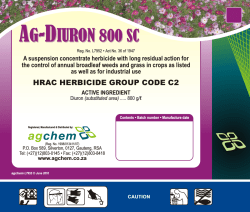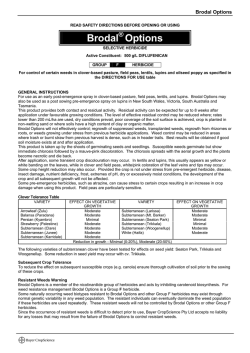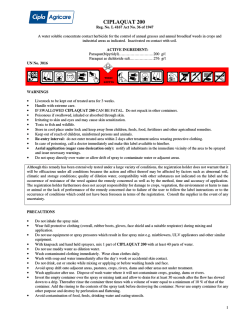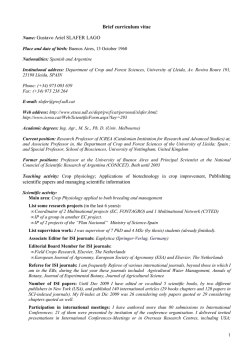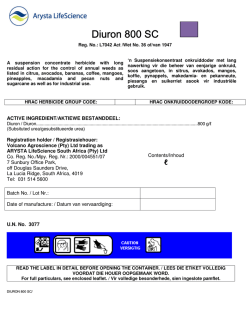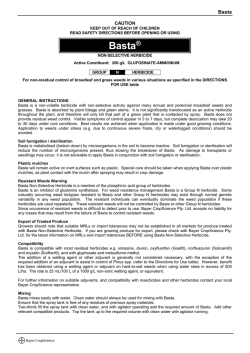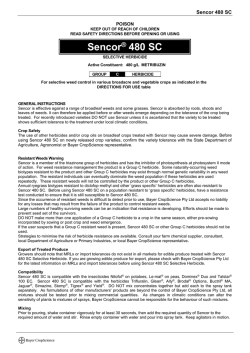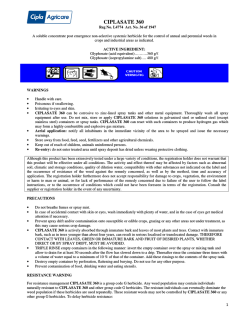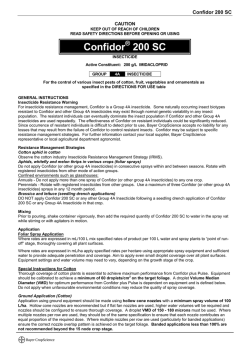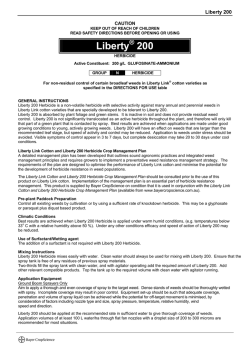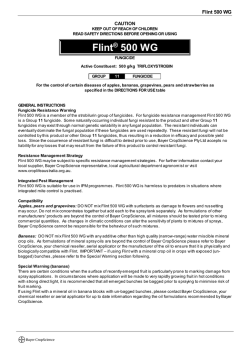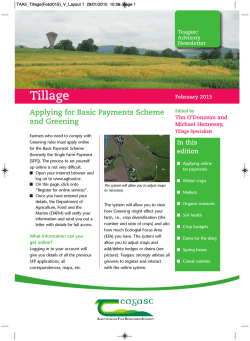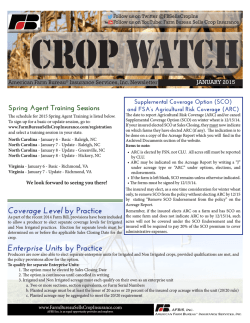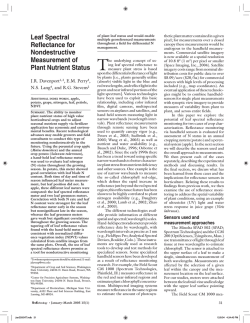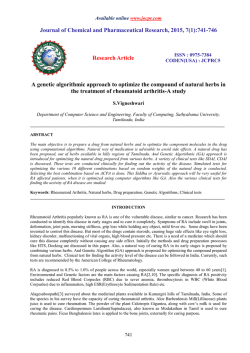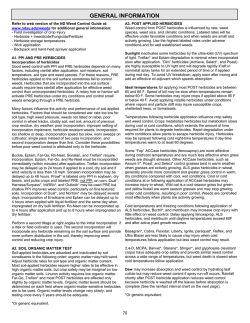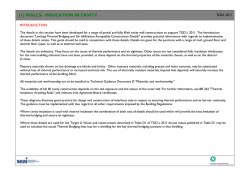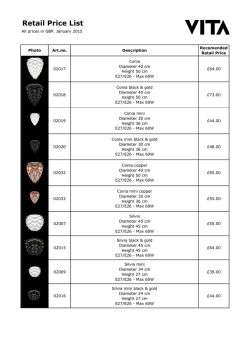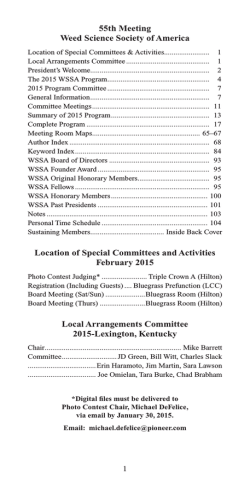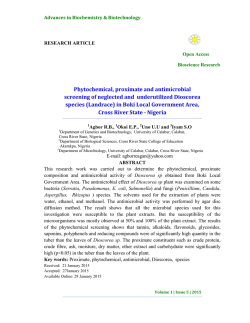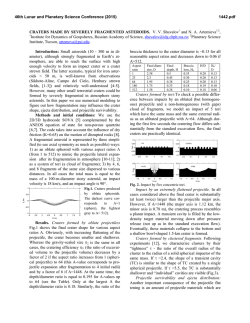
Label - Bayer CropScience
Buctril MA POISON KEEP OUT OF REACH OF CHILDREN READ SAFETY DIRECTIONS BEFORE OPENING OR USING Buctril® MA ACTIVE CONSTITUENTS: 200 g/L BROMOXYNIL present as the octanoate 200 g/L MCPA present as the ethyl hexyl ester 340 g/L LIQUID HYDROCARBON SOLVENT: GROUP C I HERBICIDE For control of broadleaf weeds in cereals, linseed and grass pastures as specified in the DIRECTIONS FOR USE Table GENERAL INSTRUCTIONS Resistant Weeds Warning Buctril MA Selective Herbicide is a member of the nitrile and phenoxy groups of herbicides. Buctril MA has both the inhibitor of photosynthesis at photosystem II and disruptor of plant cell growth modes of action. For weed resistance management Buctril MA is a Group C and I herbicide. Some naturally occurring weed biotypes resistant to Buctril MA and other Group C and I herbicides may exist through normal genetic variability in any weed population. The resistant individuals can eventually dominate the weed population if these herbicides are used repeatedly. These resistant weeds will not be controlled by Buctril MA or other Group C and I herbicides. Since the occurrence of resistant weeds is difficult to detect prior to use, Bayer CropScience Pty Ltd accepts no liability for any losses that may result from the failure of Buctril MA to control resistant weeds. Note Maximum daily temperatures at or above 20°C at application, or on days following treatment, may result in seedling mortality and established plants may be damaged. Application Mixing To ensure even mixing, half fill the spray tank with clean water and add the required amount of product. Agitate thoroughly, then add the remainder of the water. Agitate again before spraying commences. Boom Sprayer Calibrate the machine before use to ensure that the correct application rate is obtained. Check height of boom above the crop to ensure that the spray is evenly distributed. Wash the spray equipment thoroughly after use. Cereals Apply 50 to 200 litres of water per hectare. A minimum of 160 litres and preferably 200 litres of water per hectare is recommended where the weed infestation is heavy or the crop cover is dense. Complete coverage of weeds is essential. Linseed Apply a minimum of 220 litres of water per hectare. Aerial Application Apply a minimum of 22 litres of water per hectare. Markers should always move upwind before aircraft passes overhead. Application by micronaire equipment may give variable results. Compatibility This product is physically compatible in the spray tank with one of the following herbicides and insecticides in wheat and barley only: Ally®, chlorpyrifos, dicamba, dimethoate, endosulfan, Hoegrass®, MCPA and omethoate. When mixed with Ally or dicamba, do not apply to cereals undersown with lucerne. When mixed with Hoegrass, do not exceed 1.4 litres of this product per hectare. Observe all instructions on the mixture partner label. As formulations of other manufacturers' products are beyond the control of Bayer CropScience, all mixtures should be tested prior to mixing commercial quantities. PROTECTION OF LIVESTOCK Grazing Precaution Sprayed weeds may become more palatable to stock and a higher intake of some weeds may result in stock poisoning and death from causes such as nitrate poisoning. Care should be taken especially where capeweed, Paterson’s curse and variegated thistles predominate in the pasture. Avoid grazing with young or breeding stock. Do not graze horses or pigs on Paterson’s curse. If in doubt, contact your nearest Department of Agriculture. Buctril MA PROTECTION OF CROPS, NATIVE AND OTHER NON-TARGET PLANTS DO NOT apply under weather conditions or from spraying equipment which could be expected to cause spray to drift onto nearby plants, adjacent crops, crop lands or pastures. Avoid spray drift and vapour movement onto susceptible crops such as cotton, tobacco, tomatoes, vines, lupins, fruit trees and ornamentals. DO NOT apply by misting machines. PROTECTION OF WILDLIFE, FISH, CRUSTACEANS AND ENVIRONMENT Dangerous to fish. DO NOT contaminate streams, rivers or waterways with the chemical or used containers. STORAGE AND DISPOSAL Store in the closed, original container in a dry, cool, well-ventilated area out of direct sunlight. 10, 20, and 200 L containers Triple or preferably pressure rinse containers before disposal. Add rinsings to spray tank. Do not dispose of undiluted chemicals on site. If recycling, replace cap and return clean containers to recycler or designated collection point. If not recycling, break, crush, or puncture and bury empty containers in a local authority landfill. If no landfill is available, bury the containers below 500 mm in a disposal pit specifically marked and set up for this purpose clear of waterways, desirable vegetation and tree roots. Empty containers and product should not be burnt. Do not use empty container for any other purpose. 110 L returnable containers If tamper evident seals are broken prior to initial use then the integrity of the contents cannot be assured. Empty container by pumping through dry-break connection system. Do not attempt to breach the valve system or the filling point, or contaminate the container with water or other products. Ensure that the coupler, pump, meter and hoses are disconnected, triple rinsed with clean water and drained after each use. When empty, or contents no longer required, return the container to the point of purchase. This container remains the property of Bayer CropScience Pty Ltd. 1000 L containers If tamper evident seals are broken prior to initial use then the integrity of the contents cannot be assured. The container must be vented before discharging contents. To empty, connect a camlock fitted hose to the bottom valve. Remove top cap when discharging for venting purposes. When the container is empty, close all caps and valves and return the container to the point of purchase. SAFETY DIRECTIONS Product is poisonous if inhaled or swallowed. Attacks the eyes. Will irritate the skin. Avoid contact with eyes and skin. Do not inhale spray mist. When preparing the spray and using the prepared spray wear cotton overalls buttoned to the neck and wrist, a washable hat, elbow-length PVC gloves and face shield or goggles. If product in eyes, wash it out immediately with water. After use and before eating, drinking or smoking, wash hands, arms and face thoroughly with soap and water. After each day's use, wash gloves, face shield or goggles and contaminated clothing. FIRST AID If poisoning occurs, contact a doctor or Poisons Information Centre (telephone 13 11 26). If swallowed, do NOT induce vomiting. Give glass of water. MATERIAL SAFETY DATA SHEET Additional information is listed in the Material Safety Data Sheet, which can be obtained from www.bayercropscience.com.au. EXCLUSION OF LIABILITY This product must be used strictly as directed, and in accordance with all instructions appearing on the label and in other reference material. So far as it is lawfully able to do so, Bayer CropScience Pty Ltd accepts no liability or responsibility for loss or damage arising from failure to follow such directions and instructions. Buctril is a Registered Trademark of Bayer APVMA Approval No.: 31466/1209 FOR 24 HOUR SPECIALIST ADVICE IN EMERGENCY ONLY PHONE 1800 033 111 Buctril MA DIRECTIONS FOR USE Restraints DO NOT apply if crop, pasture or weeds are stressed due to dry or excessively moist conditions. DO NOT apply to diseased or frost-affected crops or if frosts are imminent. DO NOT apply if rain is expected within three hours. CROP/ SITUATION Wheat, Barley, Cereal Rye, Oats and Triticale Linseed Grass Pastures WEEDS CONTROLLED Amsinckia Capeweed Chamomile Charlock Corn Gromwell (Ironweed, Sheepweed) Fat Hen Field Madder Hexham Scent (King Island Melilot) Horned Poppy Indian Hedge Mustard Lesser Swinecress Mexican Poppy Mintweed Paterson's Curse (Salvation Jane) Rough Poppy Saffron Thistle Shepherd's Purse Slender Thistles Tree Hogweed Turnip Weed (Giant Mustard) Wild Radish Wild Turnip Black Bindweed* (Climbing Buckwheat) Common Peppercress Mustards Purple Calandrinia (Amsinckia spp.) (Arctotheca calendula) (Matricaria matricarioides) (Sinapis arvensis) (Buglossoides arvensis) (Chenopodium album) (Sherardia arvensis) (Melilotus indica) (Glaucium flavum) (Sisymbrium orientale) (Coronopus didymus) STAGE OF WEED GROWTH Plants up to the 6 leaf stage but not more than 50 mm in diameter Plants up to the 8 leaf stage but not more than 75 mm in diameter STATE RATE WA only 750 mL/ha Qld, NSW, Vic, Tas, SA, NT, ACT only 1.4 L/ha WA only 2.0 L/ha 1.4 L/ha (Sisymbrium spp.) (Calandrinia menziesii) Linseed: 50 to 150 mm high. DO NOT apply to linseed by aircraft. For optimal control, apply only when the weeds are actively growing. (Papaver hybridum) (Carthamus lanatus) (Capsella bursapastoris) (Carduus tenuiflorus, C.pycnocephalus) (Polygonum patulum) (Rapistrum rugosum) (Lepidium africanum) CROP STAGE: Wheat, Barley, Cereal Rye, Oats and Triticale: 3 leaf to fully tillered stage (Zadok Scale Z13-30) for rates of 750 mL to 1.4 L/ha; 5 leaf to fully tillered stage (Z15-30) for rate of 2.0 L/ha (NSW, Vic, SA, WA, Tas only); or early tillering to fully tillered stage (Z21-30) (Qld only). * If spraying Black Bindweed when wheat, barley, cereal rye, oats, triticale or linseed is more than 300 mm high, increase spray volume to 200 L/ha. (Argemone ochroleuca) (Salvia reflexa) (Echium plantagineum) (Raphanus raphanistrum) (Brassica tournefortii) (Fallopia convolvulus) CRITICAL COMMENTS In the early stages following spraying, temporary wilting of crop and pasture may occur. Crop scorch may occur, particularly on oats, if treatment is delayed to later stages of growth. Refer to the General Instructions. Plants up to the 4 leaf stage but not more than 35 mm in diameter Plants up to the 6 leaf stage but not more than 50 mm in diameter Plants up to the 8 leaf stage but not more than 75 mm in diameter 1.0 L/ha All States 1.4 L/ha 2.0 L/ha Avoid application when maximum daily temperatures above 20°C occur, or are likely to occur for a few days after application. DO NOT apply to crops or pastures undersown with lucerne, clover or medics unless some damage is acceptable. Buctril MA CROP/ SITUATION Wheat, Barley, Cereal Rye, Oats and Triticale WEEDS CONTROLLED Fumitory Threecornered Jack (Doublegee, Spiny Emex) (Fumaria spp.) (Emex australis) Linseed Grass Pastures Variegated Thistle Wireweed (Hogweed)** Mountain Sorrel Three-horned Bedstraw Cleavers (Silybum marianum) (Polygonum aviculare) (Oxalis acetosella) (Galium tricornutum) (Galium aparine) STAGE OF WEED GROWTH Plants up to the 3 leaf stage but not more than 50mm in diameter Plants up to the 4 leaf stage but not more than 60mm in diameter Plants up to the 5 leaf stage but not more than 75mm in diameter Plants up to the 6 leaf stage but not more than 85mm in diameter Plants up to the 4 leaf stage but not more than 35mm in diameter Plants up to the 6 leaf stage but not more than 50mm in diameter Plants up to the 6 leaf stage Plants up to the 8 leaf stage 2-4 stem stage and 13 whorls of leaves per stem STATE RATE Qld, NSW, Vic, SA, Tas only WA only 1.4 L/ha Qld, NSW, Vic, Tas, SA, NT, ACT only WA only 2.0 L/ha Qld, NSW, Vic, Tas, SA, NT ACT only WA only 750 mL/ha CRITICAL COMMENTS CROP STAGE: Wheat, Barley, Cereal Rye, Oats and Triticale: 3 leaf to fully tillered stage (Zadok Scale Z13-30) for rates of 750 mL to 1.4 L/ha; 5 leaf to fully tillered stage (Z15-30) for rate of 2.0 L/ha (NSW, Vic, SA, WA, Tas only); or early tillering to fully tillered stage (Z21-30) (Qld only). Linseed: 50 to 150 mm high. DO NOT apply to linseed by aircraft. For optimal control, apply only when the weeds are actively growing. 1.4 L/ha 750 mL/ha 1.4 L/ha 2.0 L/ha 1.4 L/ha 750 mL/ha 1.4 L/ha 750 mL/ha In the early stages following spraying, temporary wilting of crop and pasture may occur. Crop scorch may occur, particularly on oats, if treatment is delayed to later stages of growth. Refer to the General Instructions. Avoid application when maximum daily temperatures above 20°C occur, or are likely to occur for a few days after application. DO NOT apply to crops or pastures undersown with lucerne, clover or medics unless some damage is acceptable. ** Where Wireweed occurs in red soils of low fertility, it has been found to be less susceptible. In these circumstances use 2.0L/ha. NOT TO BE USED FOR ANY PURPOSE OR IN ANY MANNER CONTRARY TO THIS LABEL UNLESS AUTHORISED UNDER APPROPRIATE LEGISLATION WITHHOLDING PERIOD Harvest Cereals, linseed: NOT REQUIRED WHEN USED AS DIRECTED Grazing Cereals, pasture: DO NOT GRAZE OR CUT FOR STOCK FOOD FOR 8 WEEKS AFTER APPLICATION.
© Copyright 2026
